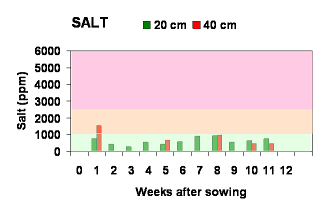
We could do this by watching the watermark sensors to check the soil did not get too dry, and at the same time ensuring that the 500 mm detectors were only activated occasionally, to check that the soil did not get too wet.
Our irrigation strategy was very influenced by the nitrate readings. The very high readings around day 13 meant that we needed to be careful not to leach the nitrate out of the profile.
For example, we measured above 500 mg nitrate/L at 300 mm depth at the start of the experiment. At a soil water content of 25%, 500 mg nitrate/L adds up to around 85 kg N per ha in the top 300 mm of soil. We add another 10 kg in the irrigation water. This would be a large proportion of the total nitrogen fertiliser the crop requires.
How well could we have done if we just had the detectors and not the nitrate, conductivity and watermark sensors?
We can draw some lessons from this experience which suit this soil type and irrigation system as follows:
We could come up with the following guidelines:
1) When the plants are small, irrigate frequently but do NOT activate a 300 mm detector. This will ensure the nutrients are not leached.
2) As the plants start to grow quickly, activate the 300 mm detector once or twice per week
3) When the crop is at a yield-sensitive growth stage (for vegetables this is usually flowering time, or ‘hearting’ time for leafy crops) activate the 500 mm detectors a couple of times.














 Between day 15 and 35, irrigation was applied every second day for about 30 minutes. During the last week of this period three larger irrigations in the range of 2-4 hours were applied to try and push water down to the detectors buried at 30 and 50 cm. Over the 15-42 day period the ‘wet side’ received an average of 2.5 mm per day and the dry side 2.1 mm per day.
Between day 15 and 35, irrigation was applied every second day for about 30 minutes. During the last week of this period three larger irrigations in the range of 2-4 hours were applied to try and push water down to the detectors buried at 30 and 50 cm. Over the 15-42 day period the ‘wet side’ received an average of 2.5 mm per day and the dry side 2.1 mm per day. 


 Tiny plants plus daily irrigation meant the soil stayed very moist on the ‘wet side’, but the irrigation events were not sufficiently long to activate the 30 cm detector. So on day 13 we did a longer irrigation (1.3 L per emitter) just so we could get a water sample at 30 cm. The nitrate level was 440 mg/L - a surprisingly high value (the pink diamond).
Tiny plants plus daily irrigation meant the soil stayed very moist on the ‘wet side’, but the irrigation events were not sufficiently long to activate the 30 cm detector. So on day 13 we did a longer irrigation (1.3 L per emitter) just so we could get a water sample at 30 cm. The nitrate level was 440 mg/L - a surprisingly high value (the pink diamond).









 The natural watertable is quite near the surface. The farmers dig holes so they can access this water. They dip the watering cans into the small pools of groundwater. Several hectares of land are irrigated using watering cans, mostly by young kids. The method seems to work well, but is incredibly time consuming. Also the Zimpeto Children's Centre is situated further up the hill where the groundwater is far too deep to access in this way.
The natural watertable is quite near the surface. The farmers dig holes so they can access this water. They dip the watering cans into the small pools of groundwater. Several hectares of land are irrigated using watering cans, mostly by young kids. The method seems to work well, but is incredibly time consuming. Also the Zimpeto Children's Centre is situated further up the hill where the groundwater is far too deep to access in this way.





















